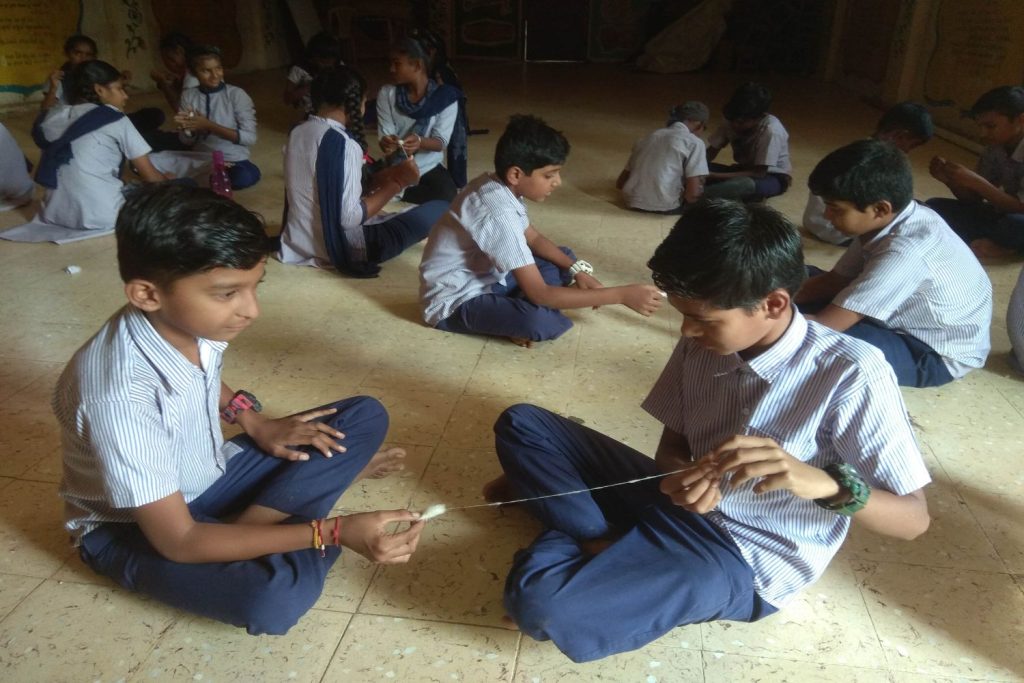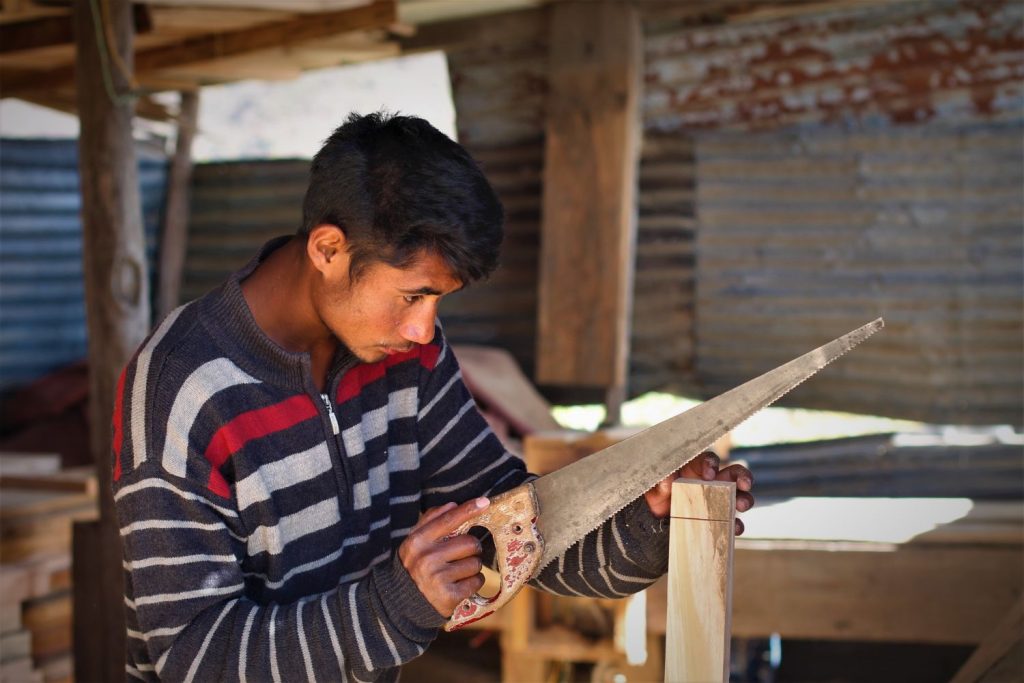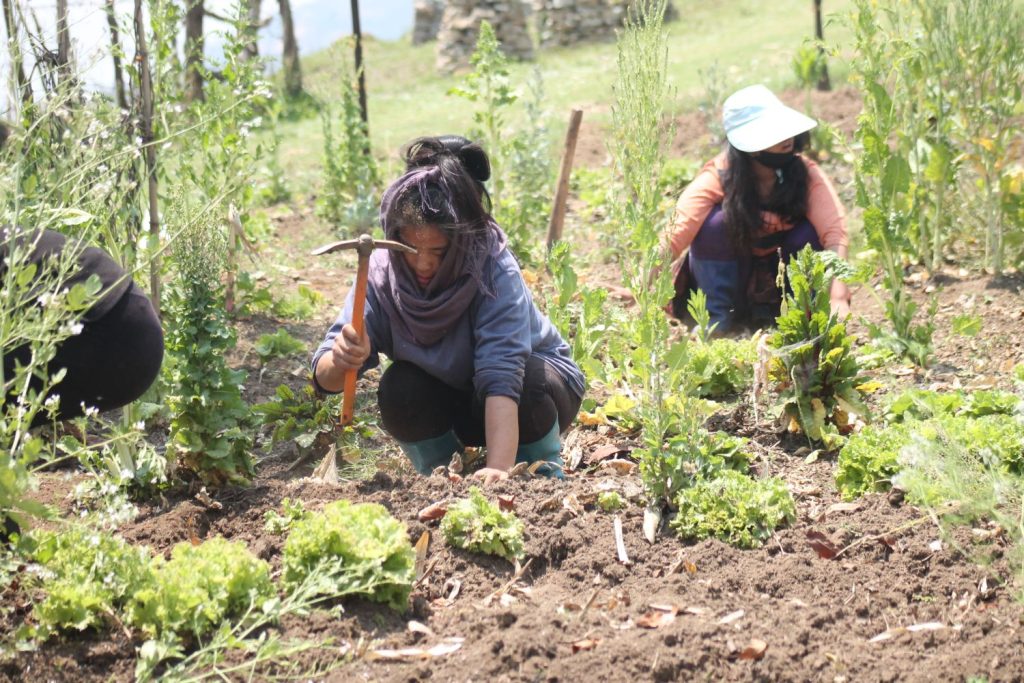Integration of work and education
The ‘Ground Zero’ piece discusses the work of three organizations from across the country (from Udaipur in Rajasthan, Kutch in Gujarat and Tawang in Arunachal Pradesh) that are pioneering innovative approaches linking work and learning. The work of these CSOs gives us hope that work can indeed become an important pedagogic tool for facilitating learning, especially of those belonging to marginalized communities.

The dialogue surrounding work has often been limited to vocational training and skill development. However, larger questions on how work can serve as a pedagogical tool, and foster the inculcation of values, have been overlooked. In this ground zero piece, we explore the perspectives of three organizations that shed light on the importance of viewing work in a holistic manner within the educational context.
Learning through crafts
After the havoc caused by the Gujarat earthquake in 2001, Khamir was established in Kachchh with the aim of repositioning and revitalizing the crafts of the region, and to ensure their sustainability for future generations of artisans. It serves as a platform for encouraging and preserving traditional handicrafts, allied cultural practices, and community and local environments.
Khamir advocates for a crafts-based curriculum inspired by the Nai Talim pedagogy advocated by Mahatma Gandhi. This is based on the idea that knowledge and work are not separate, but can be integrated to enrich each other. According to this philosophy, a child’s education should be holistic, involving the use of his head, hands and heart. This can be achieved by teaching them a useful handicraft as a medium of their holistic development.

Rushikesh from Khamir emphasizes, “The current education system is plagued by problems of rote learning, with little focus on skill development and practical learning approaches. Through our crafts-focused curriculum, we aim to integrate the craft knowledge system into the modern education system. We envision the crafts to provide a practical context, which enables and integrates the learning of all subjects such as history, science, mathematics and more.
Khyati from Khamir adds, “We have realized that many children in Kachchh are unaware of the different crafts practiced in other communities. Craft learning is often approached from a market perspective. We need to explore the social, historical, scientific, cultural, ecological and livelihood interconnections inherent in crafts through a systemic approach.”
The crafts curriculum is designed for children between grades 5 to 8, aged between 10 and 15 years, who attend rural and urban schools in Kachchh. Khamir believes that children in this age group are receptive to learning and curious about new concepts. The crafts curriculum puts children’s learning needs and their social, cultural, economic, and the political and environment context, in primary focus.
The implementation of the curriculum in schools involves collaborations between school teachers and artisans as resource teachers, with the support of Khamir.
School teachers receive training of crafts and support from Khamir resource persons through craft workshops. The team also collaborates with teachers to create content and resources for experiential and contextual teaching.
In developing the curriculum, Khamir’s plan has been to incorporate the perspectives of all stakeholders, including artisans, teachers, school management committees, panchayats, educational institutes, designers, educators, and government education departments, including DIETs.
The Khamir team has defined the scope of concepts in mathematics, science, environmental sciences, language, and social sciences. Each concept is mapped by the team to its corresponding craftsmanship, real-life experiences to be gained, and desired skills and values.
For example, in the weaving curriculum developed by the team, various concepts are interconnected. If a child is learning how to measure the amount of yarn needed to weave a fabric, mathematical concepts such as two and three-digit arithmetic operations applied through the unitary method, as well as measurements and units of weight and length, can be taught.
Children can gain experience by making their own small loom for weaving. Through these activities, children will develop skills in analytical thinking, problem-solving, measurement and estimation.
For teaching language concepts, the curriculum includes introducing children to local poetry and music in Kachchhi and Gujarati. This allows them to listen to poems and bhajans performed by local artists in their native language.
Furthermore, children are encouraged to write poems in their own language, fostering a deeper connection with artistic expression and an appreciation for diverse forms of creativity.
Developing the curriculum has presented the team with several challenges. Rushikesh and Khyati highlight that it is difficult to implement the approach in the present school structure and its timetable, which is quite inflexible.
The activities do not necessarily fit in a single period in the timetable. It requires a freer and more flexible environment to function. Consequently, the team aims to adopt a participatory approach, encouraging teachers and the school administration to take ownership, create dedicated spaces, and facilitate flexibility for the crafts curriculum. Through regular communication, the team also addresses any opposition faced from certain parents, who view crafts solely as vocational skills for livelihood, rather than recognizing their potential as a means of learning and enhancing the quality of education.
Through a crafts-based curriculum, and the integration of traditional practices into education, Khamir aims to ensure the sustainability of these crafts. This process also situates artisans as teachers and bearers of valuable knowledge. This approach has the potential to transform the educational experiences of children in schools.
Educating the heart, the mind and the body
Jhamtse Gatsal Children’s Community was established in 2006 in Tawang, Arunachal Pradesh, by a former Buddhist monk, Lobsang Phuntsok. Jhamtse Gatsal is a home and a learning community for orphaned and abandoned children from the Monpa tribe of northeast India, which has its roots in Tibet. Jhamtse Gatsal means “the garden of love and compassion” in the local language.
Vasudha Wanchoo from the team shares that the analogy of a garden represents the essence of their work. She explains, “In the lives of our children, we are the gardeners shaping their environment. Just as plants and flowers are inherently equipped with the resources they need to grow and bloom, so do our children. Our job as caregivers and educators is to provide a conducive environment so that they can learn, grow and flourish on their own.”
As part of their education model, they interweave the education of each child’s heart, mind and body. The mind is believed to provide children with the wisdom to guide their actions. The heart will help them treat everyone with compassion. And the body will enable them to acquire the skills to serve. Their pedagogy focuses on the pillars of learning, reflection and engagement. Vasudha explained that after a child receives a lesson, the focus shifts to providing the space for the child to reflect on their learning and come up with sustainable activities from within the community to engage in.

With educating the heart, the mind, and the body, and the ‘learn, reflect and engage’ pedagogy as the bedrock, the overarching goal is for the children to become selfreliant in the near future. The children are encouraged to participate in all aspects of community life, such as cleaning, cooking, and taking care of their siblings.
Rashmi from the Jhamtse team recalls, “There was a child in kindergarten who was given the responsibility to clean a certain part of the community. There was no one supervising her, and she did it with such dedication.” Encouraging the children to actively participate in various aspects of community life instills a sense of responsibility.
By integrating real-world experiences into their lessons, the children acquire practical skills and develop a deep understanding of the concepts, which stay with them. For instance, when the children were taught the concept of perimeter, the Jhamtse team came up with an activity where the children worked with the construction team to help them with their measurements and calculations.
Vasudha added, “When the children are in the kitchen cooking, they can see the concepts of chemistry come alive, such as the changing of colors when we add turmeric to our food or higher acidity from sour ingredients like tomatoes. When the children learn concepts in their classes and observe them in action, those learnings stay with them.
For example, participating in the sustainable farming practices at Jhamtse Gatsal helps our children eat nutritious and healthy food on a daily basis. It helps them understand the complexities of the environmental and socioeconomic impact of the food supply chain. It makes them see the benefits of building a strong community and social connections by farming together as well.”

Jhamtse Gatsal’s goal is not to mould children for specific careers but to empower them to make meaningful contributions to the world in their own unique ways, through their holistic approach to education.
By nurturing their innate abilities, and fostering a strong sense of compassion and self-reliance, the children of Jhamtse Gatsal Children’s Community are provided with the tools they need to lead fulfilling lives and positively impact their communities.
Learning by doing
Vidhyalay Udhyam Association – School Enterprise Network – aims to unleash the entrepreneurial capabilities of children in rural and remote areas of Udaipur, Rajasthan. The Makers Labs initiative, started by Vidhyalay Udhyam in Kasturba Gandhi Balika Vidyalayas (governmental residential schools for girls), envisions a space where children can create product prototypes to solve community problems.
These labs provide children with the freedom to experiment and learn through perseverance. Moreover, the labs offer resources for learning coding, physical computing and robotics.
Ashwani Tiwari, co-founder of Vidhyalayam Udhayam in Udaipur, Rajasthan, explained, “Work cannot be looked at in isolation from education. It is through work that children can gain skills, attitudes and values to live meaningfully. For instance, the children learned to build an LED bulb on their own. Firstly, they understood the concept of paper circuits and explored various applications. These children observed the differences between series and parallel circuits. Then they sought our assistance in soldering, and successfully built a bulb. That is the beauty of these maker spaces—they allow each child to learn by doing.”
The team draws inspiration from Mahatma Gandhi and Vinobha Bhave regarding their inclusion of work in education. They believe that these maker labs will serve as spaces where children can acquire 21st-century skills like coding and computing, and a solution-centric mindset that promotes entrepreneurial development. The team also organizes hackathons periodically, where students build innovative solutions on specific themes.
Within the makers lab, children have built localized solutions. Ashwani recounted one child realizing that adding a pulley to the well would make it easier for their mothers to draw water, and by adding gears, even less effort would be required. Another child tried to figure out using the Global Positioning System (GPS) to track their sheep, in case they got lost. The team believes that all these solutions, where children apply what they have learned in their textbooks, will foster a culture of learning by doing, innovation, and reduced fear of failure.
However, parents are often nervous about their children’s prospects and insist on them preparing for government jobs. Ashwani shared that equating the value of education solely with career prospects places an unfair burden on children, overshadowing the joy of learning.
Teachers also tend to prioritize certain skills. For instance, mechanical skills may be undervalued. Often computer operating skills are highly regarded.
Vidhyalay Udhyam believes that for a meaningful learning experience for children, the mind and the hands need to be used together. The team is attempting to build spaces that allow children to understand things in a hands-on manner.
In conclusion
In the ever-evolving education landscape of the 21st century, it is imperative to approach work and education in a more integrated manner for the holistic development of children.
Education should be approached comprehensively, incorporating work to cultivate skills, attitudes, knowledge and values, which equip children to lead lives of purpose and significance.




No approved comments yet. Be the first to comment!